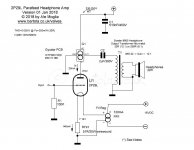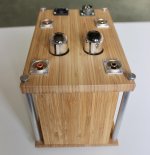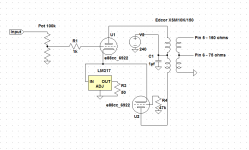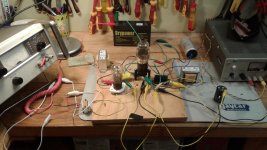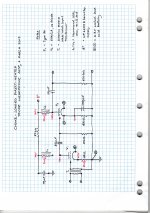Oh great ! I'm working on 71A too ! for headphones between 30-70 ohms.
I hesitate between lundhal LL2765, ratio of 12, and LL1664, ratio of 19.
So Electraprint will make an opt with a ratio of 15. Indeed seems the best ration for 71A .... too bad lundhal doesn't get one 🙁
Thank you for this information.
By the way any advice to choose between the two lundhal are welcome 🙂
Regards,
I hesitate between lundhal LL2765, ratio of 12, and LL1664, ratio of 19.
So Electraprint will make an opt with a ratio of 15. Indeed seems the best ration for 71A .... too bad lundhal doesn't get one 🙁
Thank you for this information.
By the way any advice to choose between the two lundhal are welcome 🙂
Regards,
Last edited:
I've tried the 2765 and it sounded great at 60mA using the 300B, or at 30mA using either the 45 or the 4P1L. The 45 is the least microphonic. They all sounded very good,noticeable differences are hard to hear, but I liked the most the 45. I've never had much succes using the 71A, mostly because the ones I had were very microphonic and they were prone to capturing hum.
Depending on how much output power you need, you might be ok with a configuration like 26 loaded on gyrator capacitor coupled to the 45 loaded on the 2765/30mA 12:1. You might also want to try 01A as gain stage.
I would definetely recommend separate power supply and Coleman regulators.
Good luck with your project.
Radu
Depending on how much output power you need, you might be ok with a configuration like 26 loaded on gyrator capacitor coupled to the 45 loaded on the 2765/30mA 12:1. You might also want to try 01A as gain stage.
I would definetely recommend separate power supply and Coleman regulators.
Good luck with your project.
Radu
i believe in dht also, but i´d go with tubes which can buy anywhere.
46/45 is often just nos, new stock is expensive.
2a3 is good enough.
imho-if opt is ~10x of ra, then you can omit the fb.
46/45 is often just nos, new stock is expensive.
2a3 is good enough.
imho-if opt is ~10x of ra, then you can omit the fb.
@Abszero : Thank you for thoses reports ! Wich headphones did you have use?
For 32 to 70 Ohms headphones, between LL1664 (ratio 19) and LL2765 (ratio 12) wich one could suit the best? hpeter : Yes that a part of the problem ... If I can't find any nos US DHT, I will go with 4P1L 🙂
Thank you evry one 🙂
For 32 to 70 Ohms headphones, between LL1664 (ratio 19) and LL2765 (ratio 12) wich one could suit the best? hpeter : Yes that a part of the problem ... If I can't find any nos US DHT, I will go with 4P1L 🙂
Thank you evry one 🙂
I wouldn't go for the 4P1L myself. After using it for many years you will suffer with it due to its microphonic noise. You are better off with the 2P29L. It sounds as good and has no microphonic noise at all. It's dead easy to implement in filament bias as it only needs 120mA
I've a pair of Sowter headphone OPTs which are great. You can wire it to 32 or 250R headphones. I have both. Both frequency response and distortion harmonic profile are great.
I love the sound of the Sowter. I've tried it with many DHTs and IHTs. My latest test was with the EML20A which has a mu of 20. Very detailed and great sound. A bit tricky as it can pick up hum due to its large mesh plate.
With the gain of the 2P29L which is about 8-9, you will need 4Vrms to deliver 250mW on your headphones. It'd be ok with normal line output levels as 100mW is already too loud.
Hope this helps to inspire your design
Cheers
Ale
I've a pair of Sowter headphone OPTs which are great. You can wire it to 32 or 250R headphones. I have both. Both frequency response and distortion harmonic profile are great.
I love the sound of the Sowter. I've tried it with many DHTs and IHTs. My latest test was with the EML20A which has a mu of 20. Very detailed and great sound. A bit tricky as it can pick up hum due to its large mesh plate.
With the gain of the 2P29L which is about 8-9, you will need 4Vrms to deliver 250mW on your headphones. It'd be ok with normal line output levels as 100mW is already too loud.
Hope this helps to inspire your design
Cheers
Ale
Attachments
Hello,
Thank you, yes it's helps.
Lol I juste purchase a batch of 4P1L ... Well I will try 2P29L too. What are the internal impedance of the 2P29L ?
Great we can open them 🙂
Thx
Thank you, yes it's helps.
Lol I juste purchase a batch of 4P1L ... Well I will try 2P29L too. What are the internal impedance of the 2P29L ?
Great we can open them 🙂
Thx
Last edited:
It has a higher anode resistance, about 3K. It doesn't impact in a hybrid mu-follower topology as the output impedance is given by the lower FET of the gyrator (1/gm) which is generally between 5 and 50R depending on FET and bias current. You can open the 2P29L and see a lovely valve:
Attachments
Thank you. I will give them a try 🙂 Really nice stuff !
And indeed they are relatively cheap 🙂
Too more little question :
- This dumbers can be usefull to reduce microphonics used between the socket and the chassis ? 4x M3 Rubber Column Anti-Vibration Fixed Screws f RC Flight Controller F3 F4 FPV | eBay
For dumpers, what is the needed diameters ?
Thx 🙂
And indeed they are relatively cheap 🙂
Too more little question :
- This dumbers can be usefull to reduce microphonics used between the socket and the chassis ? 4x M3 Rubber Column Anti-Vibration Fixed Screws f RC Flight Controller F3 F4 FPV | eBay
For dumpers, what is the needed diameters ?
Thx 🙂
Yes the rubber mounting isolation is quite effective. M3 is ok for the socket. If you are suspending the 4P1L sockets with a floating board you can use them as well.
I'd go for a thick top plate (at least 4mm) or wooden ones about 0.8 or 1cm - like my IKEA chopping boards in the image above
I'd go for a thick top plate (at least 4mm) or wooden ones about 0.8 or 1cm - like my IKEA chopping boards in the image above
Ok thank you, I will do that.
This kind of stuff for floating board ? 2pc 8pin 4p Ventilated Steel Mounting Plate Tube Socket Shock Proof For KT88 Amp | eBay
This kind of stuff for floating board ? 2pc 8pin 4p Ventilated Steel Mounting Plate Tube Socket Shock Proof For KT88 Amp | eBay
Last edited:
@Abszero : Thank you for thoses reports ! Wich headphones did you have use ?
For 32 to 70 Ohms headphones, between LL1664 (ratio 19) and LL2765 (ratio 12) wich one could suit the best
Thank you evry one 🙂
I've used a 250 ohms Beyerdynamics 880pro, which sounded nice on both 12:1 and 6:1 of the LL2765.
In my opinion, you should use the LL2765 which is a dedicated headphone output tranny. You'll have more power output compared to the 1664 and you'll need it when using the HE-500. Also for the same power output you'll need less gain using the LL2765.
I've seen on 6moons that the recommendation for the HE-500 is a 1 W output amplifier. So a 300B or 50 would be more appropriate for your headphones.
4p1l can also be a choice but expect a bit of microphonic sensitivity. Still think the 45 is the best compromise. And there are many options of new production, expensive though.
Cheers,
Radu
http://www.bartola.co.uk/valves/wp-content/uploads/2018/04/2P29L-Headphone-Amp.jpg
Ale. Ever got around building this amp? I'm torn between this for headphones (with the parafeed setup Sowter)and a 2P29L->4P1L PSE for speakers (and headphones? any ideas on a OPT that could work well for both? for just speakers i'm looking at NP acoustics NP5SE8F35 variant).
Yes, and many other builders have. Great headphone amp in my experience
The 4P1L may be tricky due to its microphony at headphone levels, haven’t tried though. The 2P29L works brilliantly here.
Ale
The 4P1L may be tricky due to its microphony at headphone levels, haven’t tried though. The 2P29L works brilliantly here.
Ale
I have a CCS loaded SE 4P1L parafeed amp with a 2C22 direct coupled driver. At one time, I used type 26 and 01A drivers before an issue with the filament supply to the Coleman regulars fried the boards. The transformers are 5K:8 ElectraPrint... not exactly wound for 55 ohm headphones, but it worked well and was very loud.
I recently breadboarded a CCS loaded SET 6p15p spud headamp using a toroidal power transformer as the OPT. A 230v to 5v gives a reflected load of 116k with the 55 ohm headphones. Power was less than 25mW, but it was still very loud. As a bonus... because the reflected load is so high, I was able to get satisfying low end with a relatively small (.1uF) parafeed capacitor. I did have to run the current rather high (50mA) to overcome parasitics in the transformer.
I see no reason why a toroidal couldn't be mated with the 4P1L and any DHT driver with a mu over 4.
I've got all the ingredients to try this out. I'll report back
I recently breadboarded a CCS loaded SET 6p15p spud headamp using a toroidal power transformer as the OPT. A 230v to 5v gives a reflected load of 116k with the 55 ohm headphones. Power was less than 25mW, but it was still very loud. As a bonus... because the reflected load is so high, I was able to get satisfying low end with a relatively small (.1uF) parafeed capacitor. I did have to run the current rather high (50mA) to overcome parasitics in the transformer.
I see no reason why a toroidal couldn't be mated with the 4P1L and any DHT driver with a mu over 4.
I've got all the ingredients to try this out. I'll report back
Last edited:
Just build it, very simple design but fantastic soundstage and versatility with my B&O H6 and Sennheiser HD595 ...all the best
Thant's not DHT.
Type 30 + 6A4/LA headphone amp chock full of chokes
I read (most of) this thread and started playing with DHT headphone amps on my workbench with whatever was in the cupboard.
Without any suitable output transformers to hand, I played for a while with cathode follower amps. Hmmm .... not so promising. Maybe with a choke at the cathode load? Well, I had power supply filter chokes to hand, so I tried them too. Better, but not that much better.
Then I tried the chokes as anode loads. Much better! I fooled around with unsuitable inter-stage transformers too. Promising, but bass response was compromised.
So, back to RC coupling and a line input transformer. At last! Listenable! and not bad on the measuring instruments either.
The first valve is a type 30 - the octal equivalent is the 1H4G, very cheap - loaded with a 15H Hammond choke. I've used the heater current (60mA) to assist cathode bias resistor to give a convenient 6.3V total voltage drop across the heater and the 68 Ohm bias resistor. Keep it simple. The type 30 is biased at Vgk=-4.3V, with 3mA of anode current. Gain is about 9.
The output is RC coupled to the grid of a 6A4/LA wired as a triode, loaded with a second 15H Hammond choke, drawing 20mA anode current - the valve is idling and has voltage gain of about 6. The 6A4/LA is cathode biased to Vgk=-10V and fully by-passed. Output is standard RC coupling.
The 6A4/LA has a 6.3 volt heater, sharing the same sealed lead acid battery as the type 30. The B+ is my not-so-quiet HP6209B bench-top supply.
The results? 19mW into 32 Ohms @ 1kHz, output impedance of approx 100 Ohms and THD of 0.04%. The output is -2dB at 20 Hz then +- 0.5dB from about 150Hz to over 40kHz. Quite listenable through 32 Ohm Audio Technica AD700s and 600 Ohm Sennheiser HD40s.
Pros? Listenable performance from (relatively) inexpensive chokes and valves.
Cons? Bulky and will need a VERY Quiet power supply.
I think I will build this one. 🙂
I read (most of) this thread and started playing with DHT headphone amps on my workbench with whatever was in the cupboard.
Without any suitable output transformers to hand, I played for a while with cathode follower amps. Hmmm .... not so promising. Maybe with a choke at the cathode load? Well, I had power supply filter chokes to hand, so I tried them too. Better, but not that much better.
Then I tried the chokes as anode loads. Much better! I fooled around with unsuitable inter-stage transformers too. Promising, but bass response was compromised.
So, back to RC coupling and a line input transformer. At last! Listenable! and not bad on the measuring instruments either.
The first valve is a type 30 - the octal equivalent is the 1H4G, very cheap - loaded with a 15H Hammond choke. I've used the heater current (60mA) to assist cathode bias resistor to give a convenient 6.3V total voltage drop across the heater and the 68 Ohm bias resistor. Keep it simple. The type 30 is biased at Vgk=-4.3V, with 3mA of anode current. Gain is about 9.
The output is RC coupled to the grid of a 6A4/LA wired as a triode, loaded with a second 15H Hammond choke, drawing 20mA anode current - the valve is idling and has voltage gain of about 6. The 6A4/LA is cathode biased to Vgk=-10V and fully by-passed. Output is standard RC coupling.
The 6A4/LA has a 6.3 volt heater, sharing the same sealed lead acid battery as the type 30. The B+ is my not-so-quiet HP6209B bench-top supply.
The results? 19mW into 32 Ohms @ 1kHz, output impedance of approx 100 Ohms and THD of 0.04%. The output is -2dB at 20 Hz then +- 0.5dB from about 150Hz to over 40kHz. Quite listenable through 32 Ohm Audio Technica AD700s and 600 Ohm Sennheiser HD40s.
Pros? Listenable performance from (relatively) inexpensive chokes and valves.
Cons? Bulky and will need a VERY Quiet power supply.
I think I will build this one. 🙂
Attachments
- Home
- Amplifiers
- Tubes / Valves
- The all DHT SET Headphone Amp
